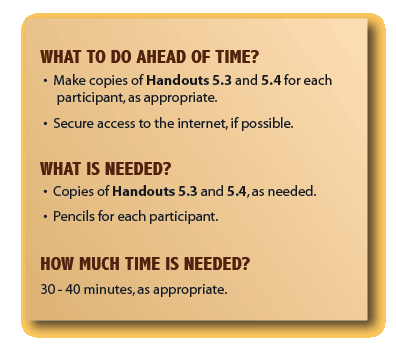
Activity 5.3: Gene Hunt
(optional)

Directions
If you want to engineer a gene and reintroduce it into a plant cell, you have to first find the gene and get enough of it to manipulate it in the laboratory. One way to do this is using PCR, or polymerase chain reaction. Participants will first be introduced to the principles of PCR in Handout 5.3 and 5.4.
Before participants begin the activity, share the following. PCR is used to amplify certain fragments of DNA. This is quite similar to activities that you can do with a word processing system. Both handouts cover the principles of PCR. Participants can perform the exercises on Handout 5.3, Handout 5.4 or both, depending upon interest. Give each participant a copy of the appropriate handout and give them time to complete this exercise.
If participants are going to complete the exercises in both handouts, wait until the participants finish Handout 5.3 before giving them Handout 5.4. The activity in Handout 5.4 will allow them to perform the process of PCR on DNA on paper - just like it occurs in a test tube in the laboratory.
After participants complete Handouts 5.3, 5.4 or both, challenge them with the following.
- Describe ways in which PCR is similar to actions that are performed with a word processing system.
- Explain what the meaning of the acronym Pick, Copy, Repeat means with regard to the process of PCR.
If participants completed Handout 5.4, ask them the following questions.
- How does the sequence of the complementary strand, Copy-C1, in Step 4 cycle differ from that of C-1 made in Step 3?
- Hint to Leader: If participants have difficulty answering this question, ask them to write out the two sequences, one right under the other.
- Why does this difference occur?
- Describe what you think will happen when you repeat these cycles over and over.
- Hint to Leader: During each cycle after the 2nd cycle, the proportion of Copy-C1 and Copy-C2 fragments will increase, resulting in thousands of copies of Copy-C-1 and Copy-C-2. The number of original strands (S-1 and S-2) will not increase. This results in a large amount of the Copy-C1 and Copy-C2 fragments.
If participants have access to the internet, this link gives a brief tutorial on the principles of PCR (screencap provided on right).
Next: Final Course